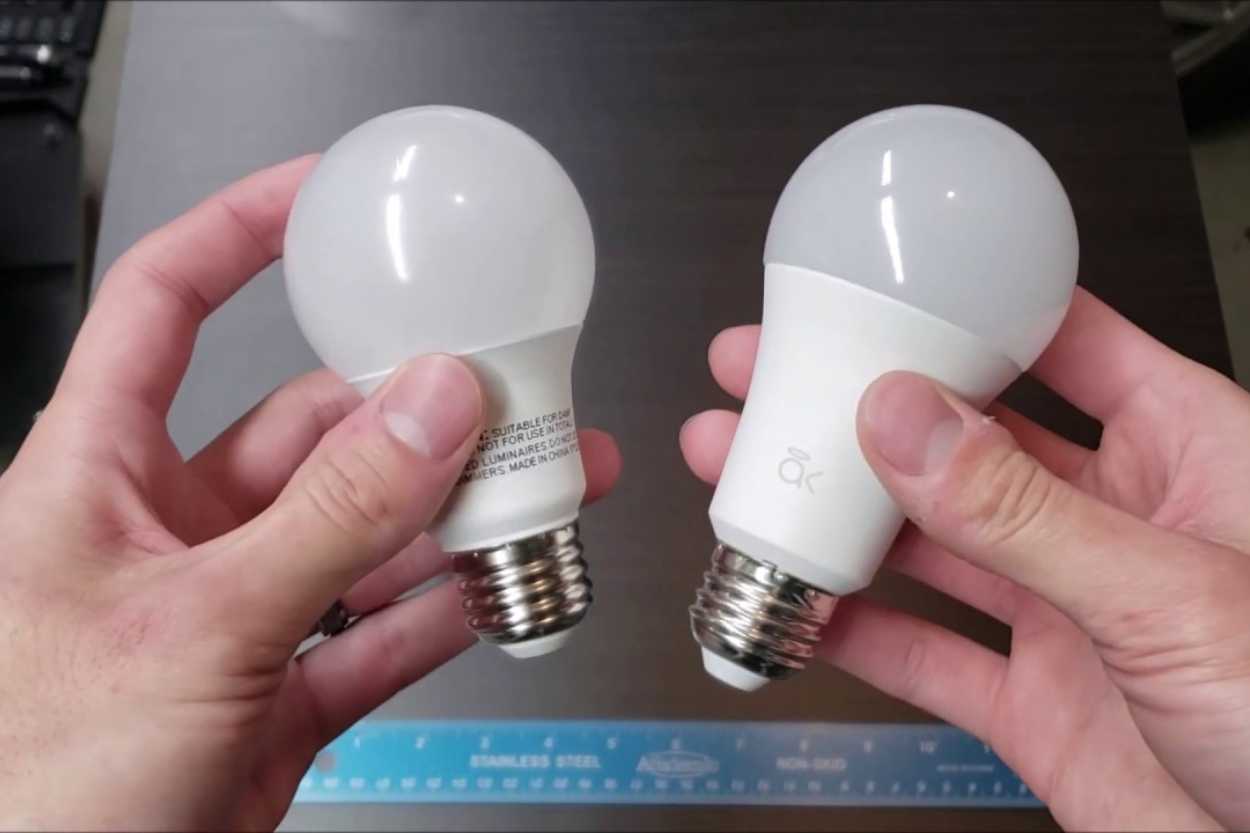The differences between A19 and A21 bulbs boil down to size and application. The A19 bulb is recognized as the standard light bulb used in most homes, and it fits into the widespread E26 base. In contrast, the A21 bulb is slightly larger and could provide a solution for those seeking more brightness and coverage from a single bulb. Both types share a similar shape and function with the A-shaped profile, but careful selection based on size can greatly impact the lighting outcome in a space.
Fundamentals of A19 and A21 Light Bulbs
The distinction between A19 and A21 light bulbs is primarily related to their size and application in standard lighting fixtures.
Dimensions and Shape
A19 bulbs are the ubiquitous option in residential lighting, traditionally possessing a diameter of approximately 2.375 inches. Their shape is characterized by a pear-like contour with a length that typically measures around 4.13 inches. A21 bulbs, on the other hand, have a marginally larger diameter of 2.625 inches and a length that is closer to 5 inches, giving them a slightly more elongated appearance. These dimensional differences have practical implications in terms of illumination and fitting into various types of lighting fixtures.
Base Compatibility
One notable aspect of both A19 and A21 light bulbs is their base compatibility. Despite their size differences, both types usually feature an E26 base, which is the standard size base for most light bulbs in the United States. This allows them to fit into the same sockets, rendering them interchangeable in many household lamps and fixtures. Their compatibility streamlines consumer choice, focusing decisions on factors such as brightness and energy efficiency rather than fit.
Performance Characteristics
When comparing A19 and A21 light bulbs, their performance characteristics such as energy efficiency, brightness, and lifespan are pivotal considerations for consumers.
Energy Efficiency
Both A19 and A21 bulbs are available with LED technology, which offers significant energy savings over traditional incandescent bulbs. A typical A19 LED bulb may consume around 9 to 12 watts, while an A21 LED bulb, due to its larger size, can use slightly more, around 15 to 17 watts. Regardless of size, LED bulbs exhibit higher energy efficiency compared to their incandescent counterparts.
Brightness and Color Temperature
The brightness of light bulbs is measured in lumens, with A19 and A21 bulbs offering a range of lumen outputs to suit various applications. A19 bulbs commonly provide around 800 lumens, which is equivalent to a 60W incandescent bulb, whereas A21 bulbs can offer higher lumens due to their larger form. Both types are available in different color temperatures, from warm soft white (2700K) to daylight (5000K), allowing users to select the desired ambiance for their space.
Lifespan
LED variants of A19 and A21 bulbs generally offer long lifespans, typically around 25,000 to 30,000 hours of use. This extended lifespan reduces the frequency of replacement and the associated maintenance costs. The actual lifespan of an individual bulb can be influenced by factors such as usage patterns and fixture compatibility.
Application and Usage
When selecting light bulbs for different settings, it is important to consider the size and brightness that A19 and A21 bulbs offer, as these factors heavily influence their appropriateness for various applications.
Residential Lighting
The A19 bulb is the classic shape most people recognize and is widely used in residential settings due to its suitable dimensions for standard lamps and fixtures. Measuring approximately 4.13 inches in height, the A19 bulb fits comfortably in table lamps, wall sconces, and ceiling fixtures. Its size is advantageous for uniformly spreading light across common areas like living rooms, bedrooms, and kitchens. This bulb’s popularity in homes is due to its balanced luminosity that provides sufficient brightness without overwhelming the space.
Commercial Lighting
For commercial spaces requiring more powerful illumination, the A21 bulb is often a better choice. Commercial environments such as office buildings, retail stores, and warehouses benefit from the A21 bulb’s larger size and generally higher luminosity. Standing at 5 inches tall, the A21 bulb’s greater surface area allows for a higher light output, which is essential for productivity and the ambiance in workspaces. Furthermore, its ability to emit more light can contribute to fewer bulbs being needed in large areas, which may lead to more efficient energy consumption and cost savings for businesses.
Environmental Impact and Disposal
The environmental impact of light bulbs, including both A19 and A21 types, is significant when considering both energy consumption during use and disposal at the end of life. They often contain materials that can be recycled, but they can also contain harmful substances that require careful disposal.
Energy Efficiency:
LED versions of A19 and A21 bulbs are energy-efficient options that have a lower environmental impact during their operational life compared to incandescent bulbs. They consume less electricity and have a longer lifespan, reducing the frequency of replacement.
Disposal Considerations:
When disposing of A19 and A21 light bulbs, especially if they are CFL (compact fluorescent lamps) or contain other electronic components, they should be treated as electronic waste due to the potential presence of mercury and other hazardous materials.
- Recycling:
Recycling is preferable, as many parts of the bulb can be reused. Local recycling programs may exist to handle these products. - Special Disposal:
If recycling is not available, follow local regulations for disposal of hazardous waste to minimize environmental harm. - Avoid Landfills:
Disposing of light bulbs in landfills can lead to the release of toxic substances into the environment. Educate consumers to prevent such disposal.
Manufacturers and consumers share responsibility for reducing the impact of light bulbs on the environment. Manufacturers must design bulbs that are easier to recycle, while consumers are urged to leverage local e-waste programs for disposal.
